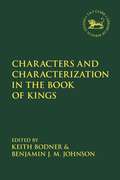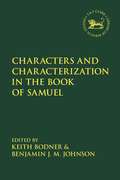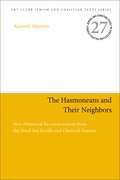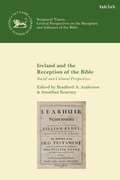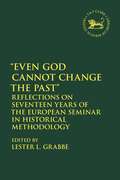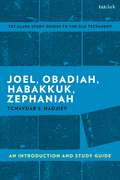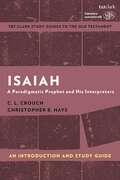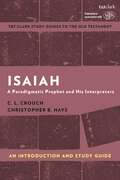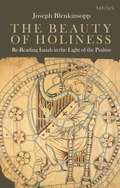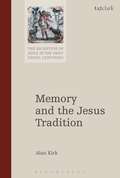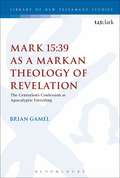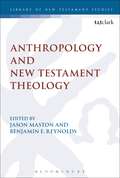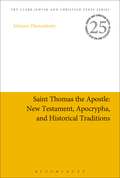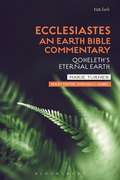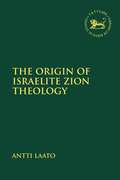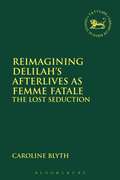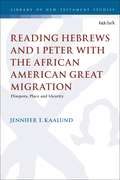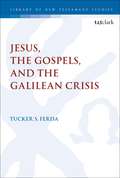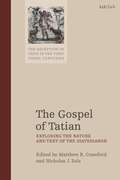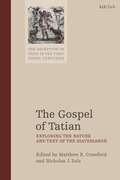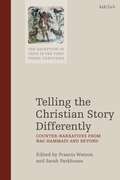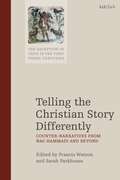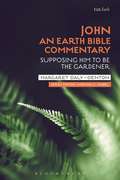- Table View
- List View
Characters and Characterization in the Book of Kings (The Library of Hebrew Bible/Old Testament Studies)
by Keith Bodner Benjamin J. M. JohnsonThis book is an examination of characters in the books of Kings; showing how understanding and interpretation of key characters affects readings of the story. The volume begins with more general pieces addressing how the study of characters can shed light on the composition history of Kings and on how characters and characterization can be considered with respect to ethics, particularly with respect to the moral complexity of biblical characters.Contributors then consider key characters within the Kings narrative in depth, such as Nathan, Bathsheba, Solomon and Jezebel. The contributors use their own specific expertise to analyze these characters and more, drawing on insights from literary theory and considering such approaches as questioning our view of a particular character with based on the character within the text with whom we identify. Contributors also assess whether or not characters as portrayed in the biblical text necessarily match up to their possible counterparts in history.
Characters and Characterization in the Book of Samuel (The Library of Hebrew Bible/Old Testament Studies)
by Keith Bodner Benjamin J. M. JohnsonCharacters provide the entry point to the story of the books of Samuel, just as they do in all stories. In this book the history of research into characters in Samuel, and the role(s) they play in the text are examined and discussed. The contributors look at the interpretative function of characters in the Samuel stories, and at issues of textual composition and what profiling of characters within the text can add to theories surrounding this issue. Specific characters are also profiled and studied. The character of God is examined: is God kind towards Israel? Is God loving and 'worthy to be praised' 2 Sam 22.4. Characters such as Hannah are examined from the perspective of literary type, as well as Eli as priest and Samuel himself as prophet. All of the major characters within the books are studied, including David and Jonathan, and chapters also treat the minor characters and offer information on their roles in the structure of the text. The contributors provide a range of different approaches to characterization, according to their specific expertise, and provide a thorough handbook to the characters in Samuel and their roles in the literary make-up of the text.
The Hasmoneans and Their Neighbors: New Historical Reconstructions from the Dead Sea Scrolls and Classical Sources (Jewish and Christian Texts)
by Kenneth AtkinsonKenneth Atkinson adds to an already impressive body of work on the Hasmoneans, proposing that the history and theological beliefs of Jews during the period of the Hasmonean state cannot be understood without a close investigation of the histories of the Ptolemaic and Seleucid Empires, as well as the Roman Republic. Citing evidence from the Dead Sea Scrolls and classical sources, Atkinson offers a new reconstruction of this vital historical period, when the Hasmonean family changed the fates of their neighbors, the Roman Republic, the religion of Judaism, and created the foundation for the development of the nascent Christian faith.Atkinson additionally provides reconstructions of events in classical history, including the most detailed examination of Pompey the Great's assassination in light of Jewish sources; by focusing on his death, this volume uncovers new information that explains the discrepancies in the classical accounts of this pivotal event that shaped Middle Eastern and Roman history, and which helped end the Republic. Collecting sources ranging from the beginning of the Hasmonean monarchy, through its religious strife and golden age, to its eventual downfall, Atkinson concludes that that Jewish sectarianism and messianism played far greater roles in the Hasmonean state than has previously be assumed.
Ireland and the Reception of the Bible: Social And Cultural Perspectives (The Library of Hebrew Bible/Old Testament Studies)
by Dr Bradford A. Anderson Dr Jonathan KearneyDrawing on the work of leading figures in biblical, religious, historical, and cultural studies in Ireland and beyond, this volume explores the reception of the Bible in Ireland, focusing on the social and cultural dimensions of such use of the Bible. This includes the transmission of the Bible, the Bible and identity formation, engagement beyond Ireland, and cultural and artistic appropriation of the Bible. The chapters collected here are particularly useful and insightful for those researching the use and reception of the Bible, as well as those with broader interests in social and cultural dimensions of Irish history and Irish studies.The chapters challenge the perception in the minds of many that the Bible is a static book with a fixed place in the world that can be relegated to ecclesial contexts and perhaps academic study. Rather, as this book shows, the role of the Bible in the world is much more complex. Nowhere is this clearer than in Ireland, with its rich and complex religious, cultural, and social history. This volume examines these very issues, highlighting the varied ways in which the Bible has impacted Irish life and society, as well as the ways in which the cultural specificity of Ireland has impacted the use and development of the Bible both in Ireland and further afield.
Even God Cannot Change the Past: Reflections on Seventeen Years of the European Seminar in Historical Methodology (The Library of Hebrew Bible/Old Testament Studies)
by Lester L. GrabbeThis volume represents the final publication of the European Seminar in Historical Methodology. The volume reflects on the ground-breaking work of this prestigious seminar in the field of biblical history. In part one, long-term members of the seminar (Bob Becking, Ehud Ben Zvi, Philip R. Davies, Ernst Axel Knauf, Niels Peter Lemche, Thomas L Thompson) provide reflections on its work. Part two presents an opportunity for readers to benefit from contributions that have remained heretofore unpublished. This includes material on the Persian period, questions of orality and writing, and contributions on the Maccabean period. Bringing these papers together in a published form provides a fitting way to round out the work of this significant endeavour in historical methodology.
Joel, Obadiah, Habakkuk, Zephaniah: An Introduction and Study Guide (T&T Clark’s Study Guides to the Old Testament)
by Tchavdar S. HadjievTchavdar S. Hadjiev introduces students to the books of Joel, Obadiah, Habakkuk, and Zephaniah (the Minor Prophets) in their original historical contexts and to the issues surrounding their composition and interpretation.Hadjiev pays particular attention to important topics such as eschatology, prophecy and cult, intertextuality, theodicy and the genre of the prophetic book. Readers will come to grips with the key themes of judgment, repentance, and salvation in relation to their historical and canonical contexts. Finally, Hadjiev provides a theological evaluation of the prophetic attitude to foreigners and the vision of their final destruction, which is pervasive in Joel, Obadiah, Habakkuk and Zephaniah, and helps readers to grapple with this theme in a modern context.
Joel, Obadiah, Habakkuk, Zephaniah: An Introduction and Study Guide (T&T Clark’s Study Guides to the Old Testament)
by Tchavdar S. HadjievTchavdar S. Hadjiev introduces students to the books of Joel, Obadiah, Habakkuk, and Zephaniah (the Minor Prophets) in their original historical contexts and to the issues surrounding their composition and interpretation.Hadjiev pays particular attention to important topics such as eschatology, prophecy and cult, intertextuality, theodicy and the genre of the prophetic book. Readers will come to grips with the key themes of judgment, repentance, and salvation in relation to their historical and canonical contexts. Finally, Hadjiev provides a theological evaluation of the prophetic attitude to foreigners and the vision of their final destruction, which is pervasive in Joel, Obadiah, Habakkuk and Zephaniah, and helps readers to grapple with this theme in a modern context.
Isaiah: A Paradigmatic Prophet and His Interpreters (T&T Clark’s Study Guides to the Old Testament)
by C.L. Crouch Christopher B. HaysC. L. Crouch and Christopher B. Hays introduce the Book of Isaiah in its diverse historical contexts, tracing its origins and development over several centuries: beginning with the career of the prophet Isaiah ben Amoz in eighth century Jerusalem, continuing with a late seventh century edition and the further revisions made in the late sixth century, and concluding with final shaping during the Persian Period. At each stage Crouch and Hays pay close attention to the historical, cultural, and theological conversations that influenced the book's aims and interests. Crouch and Hays discuss the theological and literary continuities among the book's contributors, as well as where language and concerns differed from generation to generation. They also consider the reception history of Isaiah and what the text has meant to people through history. With suggestions of further reading at the end of each chapter, this guide will be an essential accompaniment to study of the Book of Isaiah.
Isaiah: A Paradigmatic Prophet and His Interpreters (T&T Clark’s Study Guides to the Old Testament)
by C.L. Crouch Christopher B. HaysC. L. Crouch and Christopher B. Hays introduce the Book of Isaiah in its diverse historical contexts, tracing its origins and development over several centuries: beginning with the career of the prophet Isaiah ben Amoz in eighth century Jerusalem, continuing with a late seventh century edition and the further revisions made in the late sixth century, and concluding with final shaping during the Persian Period. At each stage Crouch and Hays pay close attention to the historical, cultural, and theological conversations that influenced the book's aims and interests. Crouch and Hays discuss the theological and literary continuities among the book's contributors, as well as where language and concerns differed from generation to generation. They also consider the reception history of Isaiah and what the text has meant to people through history. With suggestions of further reading at the end of each chapter, this guide will be an essential accompaniment to study of the Book of Isaiah.
The Beauty of Holiness: Re-Reading Isaiah in the Light of the Psalms
by Joseph BlenkinsoppJoseph Blenkinsopp presents an intertextual reading of Isaiah and the Psalms furthering his previous well-known work on the text of Isaiah. Blenkinsopp argues that, read together, these two biblical books can be shown to form a single religious vision, a way of experiencing and articulating a commitment to the fundamentals of the faith of Israel, with its own distinctive character. Blenkinsopp shows how the emphasis in Isaiah and the Psalms is on affect and emotion, the expression of joy and sorrow articulated in music, singing, and dancing; in praise, thanksgiving and lament. This represents a key difference from other parts of the Hebrew Bible where the focus is more on the Law and on the covenant at Sinai – in Isaiah and the Psalms these terms rarely occur, the focus is instead on Zion and on the Temple. Blenkinsopp shows how the temple singers, with their close connections with the circles which transmitted and eventually committed to writing the Book of Isaiah, demonstrate that the divine word is not incompatible with other forms of religious experience and expression, affective and even mystical, articulated and embodied in the performance of music, song, ritual prayer, and dance. The beauty of the Psalms is echoed strongly in Isaiah, and the Isaian vision of a Creator God, Lord of nature and history beyond the bounds of Israel, is joyfully proclaimed by the psalmists.
The Beauty of Holiness: Re-Reading Isaiah in the Light of the Psalms
by Joseph BlenkinsoppJoseph Blenkinsopp presents an intertextual reading of Isaiah and the Psalms furthering his previous well-known work on the text of Isaiah. Blenkinsopp argues that, read together, these two biblical books can be shown to form a single religious vision, a way of experiencing and articulating a commitment to the fundamentals of the faith of Israel, with its own distinctive character. Blenkinsopp shows how the emphasis in Isaiah and the Psalms is on affect and emotion, the expression of joy and sorrow articulated in music, singing, and dancing; in praise, thanksgiving and lament. This represents a key difference from other parts of the Hebrew Bible where the focus is more on the Law and on the covenant at Sinai – in Isaiah and the Psalms these terms rarely occur, the focus is instead on Zion and on the Temple. Blenkinsopp shows how the temple singers, with their close connections with the circles which transmitted and eventually committed to writing the Book of Isaiah, demonstrate that the divine word is not incompatible with other forms of religious experience and expression, affective and even mystical, articulated and embodied in the performance of music, song, ritual prayer, and dance. The beauty of the Psalms is echoed strongly in Isaiah, and the Isaian vision of a Creator God, Lord of nature and history beyond the bounds of Israel, is joyfully proclaimed by the psalmists.
Memory and the Jesus Tradition: Ancient Media, Memory, And Early Scribal Transmission Of The Jesus Tradition (The Reception of Jesus in the First Three Centuries #564)
by Alan KirkAlan Kirk argues that memory theory, in its social, cultural, and cognitive dimensions, is able to provide a comprehensive account of the origins and history of the Jesus tradition, one capable of displacing the moribund form-critical model. He shows that memory research gives new leverage on a range of classic problems in gospels, historical Jesus, and Christian origins scholarship. This volume brings together 12 essays published between 2001 and 2016, newly revised for this edition and organized under the rubrics of: 'Memory and the Formation of the Jesus Tradition'; 'Memory and Manuscript'; 'Memory and Historical Jesus Research'; and 'Memory in 2nd Century Gospel Writing'. The introductory essay, written for this volume, argues that the old form critical model, in marginalizing memory, abandoned the one factor actually capable of accounting for the origins of the gospel tradition, its manifestation in oral and written media, and its historical trajectory.
Mark 15: The Centurion's Confession as Apocalyptic Unveiling (The Library of New Testament Studies)
by Brian K. GamelIn the Gospel of Mark, Jesus' arrest, trial and execution ends with the Roman centurion who oversees the death process proclaiming Jesus as God's son. Gamel explores two key questions in relation to this moment: what does the centurion mean when he says that Jesus is God's son, and why does he say it? The confession is not made on the basis of any signs nor from any indication that he perceives Jesus' death as honourable or exemplary. This apparent lack of motivation itself highlights a key Markan theme: that this insight is revealed by an apocalyptic act of God, signalled by the tearing of the temple veil. Thus the confession, which we can understand to be made sincerely and knowledgeably, is the result of an act of God's revelation alone. Gamel explores the theory of Mark depicting a story in which all human characters exhibit varying levels of blindness to the spiritual realities that govern their lives. By making a thorough examination of Mark's Gospel – while placing primary focus on the centurion, the study is unlimited and presents a serious examination of the whole Gospel – Gamel concludes his argument with the point that, at the foot of the cross, this blindness is decisively confronted by God's apocalyptic act. The offer of sight to the centurion demonstrates the reconciliation of God and humanity which are otherwise in Mark's Gospel repeatedly presented as antagonistic spheres. Finally, the fact that revelation is offered to a Gentile highlights the inclusion of the nations into the promises of Israel.
Anthropology and New Testament Theology (The Library of New Testament Studies #529)
by Benjamin E. Reynolds Dr Jason MastonThis volume considers the New Testament in the light of anthropological study, in particular the current trend towards theological anthropology. The book begins with three essays that survey the context in which the New Testament was written, covering the Old Testament, early Jewish writings and the literature of the Greco –Roman world. Chapters then explore the anthropological ideas found in the texts of the New Testament and in the thought of it writers, notably that of Paul. The volume concludes with pieces from Brian S. Roser and Ephraim Radner who bring the whole exploration together by reflecting on the theological implications of the New Testament's anthropological ideas.Taken together, the chapters in this volume address the question that humans have been asking since at least the earliest days of recorded history: what does it mean to be human? The presence of this question in modern theology, and its current prevalence in popular culture, makes this volume both a timely and relevant interdisciplinary addition to the scholarly conversation around the New Testament.
Saint Thomas the Apostle: New Testament, Apocrypha, and Historical Traditions (Jewish and Christian Texts #25)
by Dr Johnson ThomaskuttyAre the Thomas references in the Gospel of John, the Thomas compositions, and the early Thomas traditions in northwestern and southern India purely legendary as biblical scholars have assumed or do they preserve unexamined historical traditions intermittently as the Thomas Christians in India have believed?Didymus Judas Thomas is one of the most misunderstood characters from the beginning of the New Testament history and interpretation. In this study, Thomaskutty addresses the following questions: whether Thomas was merely a 'doubting Thomas' or a 'genuine Thomas'? Can we understand Thomas comprehensively by bringing the New Testament, apocrypha, and historical traditions together? How was Thomas connected to eastern Christianity and how does the Thomas literature support/not support this connectivity? Can we understand the Thomas traditions related to Judea, Syria, and India with the help of canonical, extra canonical, and traditio-historical documents? Thomaskutty investigates the development of the Thomas literature right from the beginning, examining and questioning the approaches and methodologies that have been employed in interpreting these documents, and analyzes the Thomas literature closely in order to understand the character, his mission involvements, and the possible implications this may have for understanding early Christianity in the east.
Ecclesiastes: Qoheleth's Eternal Earth (Earth Bible Commentary)
by Dr Marie TurnerQoheleth is one of the most challenging and intriguing of the biblical authors. Above all, he is attentive to life's realities, neither optimistic about the world nor unappreciative of its goodness and pleasures. In this volume, Turner examines the writings of Qoheleth in the book of Ecclesiastes and provides an ecological reading of the text that gives readers clear insights into how biblical wisdom literature can be used to respond to the challenges facing the environment in the present day, as well as advancing the field of ecological hermeneutics. In this commentary Turner looks at the concept of Qoheleth's 'eternal earth', moving through the chapters of Ecclesiastes with an ear attuned to the voice of the Earth as it struggles to be heard above the voice of the economy. Such a voice is not necessarily antagonistic to that of Earth, but neither is it neutral. The ecological reader knows that a prudent economy is necessary for living, but if it is given precedence at the expense of Earth, there will be no future, let alone 'eternity', for Earth. Eco-justice demands that contemporary readers should be mindful of future generations and heed Qoheleth's counsel to value the fruits of one's labour without greed, allowing ecological hermeneutics to provide insights into contemporary environmental issues. Illustrating how a biblical framework for environmentally responsible living may be generated, Turner's analysis is vital both to those studying Qoheleth and to those invested in the Bible and ecology.
The Origin of Israelite Zion Theology (The Library of Hebrew Bible/Old Testament Studies)
by Antti LaatoIn this examination of Zion theology and how it arises in the book of Psalms Antti Laato's starting-point is that the Hebrew Bible is the product of the exilic and postexilic times, which nonetheless contains older traditions that have played a significant role in the development of the text. Laato seeks out these older mythical traditions related to Zion using a comparative methodology and looking at Biblical traditions alongside Ugaritic texts and other ancient Near Eastern material. As such Laato provides a historical background for Zion theology which he can apply more broadly to the Psalms.In addition, Laato argues that Zion-related theology in the Psalms is closely related to two events recounted in the Hebrew Bible. First, the architectural details of the Temple of Solomon (1 Kings 6-7), which can be compared with older mythical Zion-related traditions. Second, the religious traditions related to the reigns of David and Solomon such as the Ark Narrative, which ends with David's transfer of the Ark to Jerusalem (2 Sam 6). From this Laato builds an argument for a possible setting in Jerusalem at the time of David and Solomon for the Zion theology that emerges in the Psalms.
Reimagining Delilah’s Afterlives as Femme Fatale: The Lost Seduction (The Library of Hebrew Bible/Old Testament Studies)
by Dr Caroline BlythThe story of Samson and Delilah in Judges 16 has been studied and retold over the centuries by biblical interpreters, artists, musicians, filmmakers and writers. Within these scholarly and cultural retellings, Delilah is frequently fashioned as the quintessential femme fatale - the shamelessly seductive 'fatal woman' whose sexual treachery ultimately leads to Samson's downfall. Yet these ubiquitous portrayals of Delilah as femme fatale tend to eclipse the many other viable readings of her character that lie, underexplored, within the ambiguity-laden narrative of Judges 16 - interpretations that offer alternative and more sympathetic portrayals of her biblical persona. In Reimagining Delilah's Afterlives as Femme Fatale, Caroline Blyth guides readers through an in-depth exploration of Delilah's afterlives as femme fatale in both biblical interpretation and popular culture, tracing the social and historical factors that may have inspired them. She then considers alternative afterlives for Delilah's character, using as inspiration both the Judges 16 narrative and a number of cultural texts which deconstruct traditional understandings of the femme fatale, thereby inviting readers to view this iconic biblical character in new and fascinating lights.
Reading Hebrews and 1 Peter with the African American Great Migration: (dis)locating Diaspora (The Library of New Testament Studies)
by Dr Jennifer T. KaalundKaalund examines the constructed and contested Christian-Jewish identities in Hebrews and 1 Peter through the lens of the "New Negro,†? a diasporic identity similarly constructed and contested during the Great Migration in the early 20th century. Like the identity "Christian,†? the New Negro emerged in a context marked by instability, creativity, and the need for a sense of permanence in a hostile political environment. Upon examination, both identities also show complex internal diversity and debate that disrupts any simple articulation as purely resistant (or accommodating) to its hegemonic and oppressive environment. Kaalund's investigation into the construction of the New Negro highlights this multiplicity and contends that the rhetoric of place, race, and gender were integral to these processes of inventing a way of being in the world that was seemingly not reliant on one's physical space. Putting these issues into dialogue with 1 Peter and Hebrews allows for a reading of the formation of Christian identity as similarly engaging the rhetoric of place and race in constructive and contested ways.
Jesus, the Gospels, and the Galilean Crisis (The Library of New Testament Studies)
by Tucker S. FerdaTucker S. Ferda examines the theory of the Galilean crisis: the notion that the historical Jesus himself had grappled with the failure of his mission to Israel. While this theory has been neglected since the 19th century, due to research moving to consider the response of the early church to the rejection of the gospel, Ferda now provides fresh insight on Jesus' own potential crisis of faith.Ferda begins by reconstructing the origin of the crisis theory, expanding upon histories of New Testament research and considering the contributions made before Hermann Samuel Reimarus. He shows how the crisis theory was shaped by earlier and so-called “pre-critical” gospel interpretation and examines how, despite the claims of modern scholarship, the logic of the crisis theory is still a part of current debate. Finally, Ferda argues that while the crisis theory is a failed hypothesis, its suggestions on early success and growing opposition in the ministry, as well as its claim that Jesus met and responded to disappointing cases of rejection, should be revisited. This book resurrects key historical aspects of the crisis theory for contemporary scholarship.
The Gospel of Tatian: Exploring the Nature and Text of the Diatessaron (The Reception of Jesus in the First Three Centuries #3)
by Matthew R. Crawford Nicholas J. ZolaThis volume combines some of the leading voices on the composition and collection of early Christian gospels in order to analyze Tatian's Diatessaron. The rapid rise and sudden suppression of the Diatessaron has raised numerous questions about the nature and intent of this second-century composition. It has been claimed as both a vindication of the fourfold gospel's early canonical status and as an argument for the canon's on-going fluidity; it has been touted as both a premiere witness to the earliest recoverable gospel text and as an early corrupting influence on that text. Collectively, these essays provide the greatest advance in Diatessaronic scholarship in a quarter of a century.The contributors explore numerous questions: did Tatian intend to supplement or supplant the fourfold gospel? How many were his sources and how free was he with their text? How do we identify a Diatessaronic witness? Is it legitimate to use Tatian's Diatessaron as a source in New Testament textual criticism? Is a reconstruction of the Diatessaron still possible? These queries in turn contribute to the question of what the Diatessaron signifies with respect to the broader context of gospel writing, and what this can tell us about how the writing, rewriting and reception of gospel material functioned in the first and second centuries and beyond.
The Gospel of Tatian: Exploring the Nature and Text of the Diatessaron (The Reception of Jesus in the First Three Centuries)
by Matthew R. Crawford Nicholas J. ZolaThis volume combines some of the leading voices on the composition and collection of early Christian gospels in order to analyze Tatian's Diatessaron. The rapid rise and sudden suppression of the Diatessaron has raised numerous questions about the nature and intent of this second-century composition. It has been claimed as both a vindication of the fourfold gospel's early canonical status and as an argument for the canon's on-going fluidity; it has been touted as both a premiere witness to the earliest recoverable gospel text and as an early corrupting influence on that text. Collectively, these essays provide the greatest advance in Diatessaronic scholarship in a quarter of a century.The contributors explore numerous questions: did Tatian intend to supplement or supplant the fourfold gospel? How many were his sources and how free was he with their text? How do we identify a Diatessaronic witness? Is it legitimate to use Tatian's Diatessaron as a source in New Testament textual criticism? Is a reconstruction of the Diatessaron still possible? These queries in turn contribute to the question of what the Diatessaron signifies with respect to the broader context of gospel writing, and what this can tell us about how the writing, rewriting and reception of gospel material functioned in the first and second centuries and beyond.
Telling the Christian Story Differently: Counter-Narratives from Nag Hammadi and Beyond (The Reception of Jesus in the First Three Centuries)
by Francis Watson Sarah ParkhouseThis volume examines the 'counter-narratives' of the core Christian story, proposed by texts from Nag Hammadi and elsewhere. A noteworthy body of highly respected scholars examine material that is sometimes difficult and often overlooked, contributing to the ongoing effort to integrate Nag Hammadi and related literature into the mainstream of New Testament and early Christian studies. By retracing the major elements of the Christian story in sequence, they are able to discuss how and why each aspect was disputed on inner-Christian grounds, and to reflect on the different accounts of Christian identity underlying these disputes. Together the essays in this book address a central issue: towards the end of the second century, Irenaeus could claim that the overwhelming majority of Christians throughout the world were agreed on a version of the core Christian story which is still recognisable today. Yet, as Irenaeus concedes and as the Nag Hammadi texts have confirmed, there were many who wished to tell the core Christian story differently. Those who criticized and rejected the standard story did so not because they were adherents of another religion, 'Gnosticism', but because they were Christians who believed that the standard account was wrong at point after point. Ranging from the Gospels of Judas and Mary to Galatians and Ptolemy's Letter to Flora, this volume provides a fascinating analysis of how the Christian story as we know it today developed against counter-readings from other early Christian traditions.
Telling the Christian Story Differently: Counter-Narratives from Nag Hammadi and Beyond (The Reception of Jesus in the First Three Centuries)
by Francis Watson Sarah ParkhouseThis volume examines the 'counter-narratives' of the core Christian story, proposed by texts from Nag Hammadi and elsewhere. A noteworthy body of highly respected scholars examine material that is sometimes difficult and often overlooked, contributing to the ongoing effort to integrate Nag Hammadi and related literature into the mainstream of New Testament and early Christian studies. By retracing the major elements of the Christian story in sequence, they are able to discuss how and why each aspect was disputed on inner-Christian grounds, and to reflect on the different accounts of Christian identity underlying these disputes. Together the essays in this book address a central issue: towards the end of the second century, Irenaeus could claim that the overwhelming majority of Christians throughout the world were agreed on a version of the core Christian story which is still recognisable today. Yet, as Irenaeus concedes and as the Nag Hammadi texts have confirmed, there were many who wished to tell the core Christian story differently. Those who criticized and rejected the standard story did so not because they were adherents of another religion, 'Gnosticism', but because they were Christians who believed that the standard account was wrong at point after point. Ranging from the Gospels of Judas and Mary to Galatians and Ptolemy's Letter to Flora, this volume provides a fascinating analysis of how the Christian story as we know it today developed against counter-readings from other early Christian traditions.
John: Supposing Him To Be The Gardener (Earth Bible Commentary)
by Margaret Daly-DentonThis volume in the Earth Bible Commentary Series suggests how John's Gospel might motivate and resource a Christian response to the ecological crisis. Margaret Daly-Denton shows how aptly Mary Magdalene recognized the risen Jesus as 'the gardener' (Jn 20.15), completing his day's work in the 'garden' of the Earth. The Johannine story of Jesus offers his present day followers a paradigm with considerable potential to inspire Earth care, sustainable living and commitment to eco-justice. The Fourth Evangelist believes that Jesus fulfils the Jewish hope for a restoration envisaged as a return of humankind to Eden. Keeping this theme continually in mind, Daly-Denton reads the gospel with sensitivity to the role of the more-than-human world in the narrative and with particular attention to the scriptural underlay that repeatedly brings this world into the foreground. The commentary begins with an exploration of the memories and associations that the garden setting would have evoked for the intended audience. It then follows the gospel's spiral path that eventually leads to the garden of Mary's encounter. Each chapter concludes by asking how believers might do God's work (Jn 6.28) in today's ecologically damaged world and by offering practical suggestions indicative of the reflection that readers of the commentary will be able to do in their own setting.
